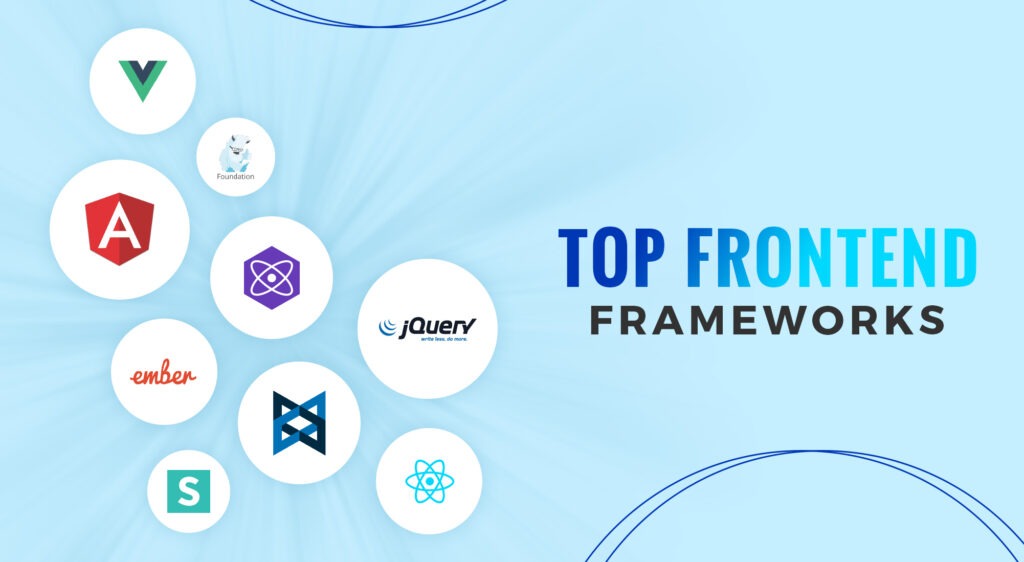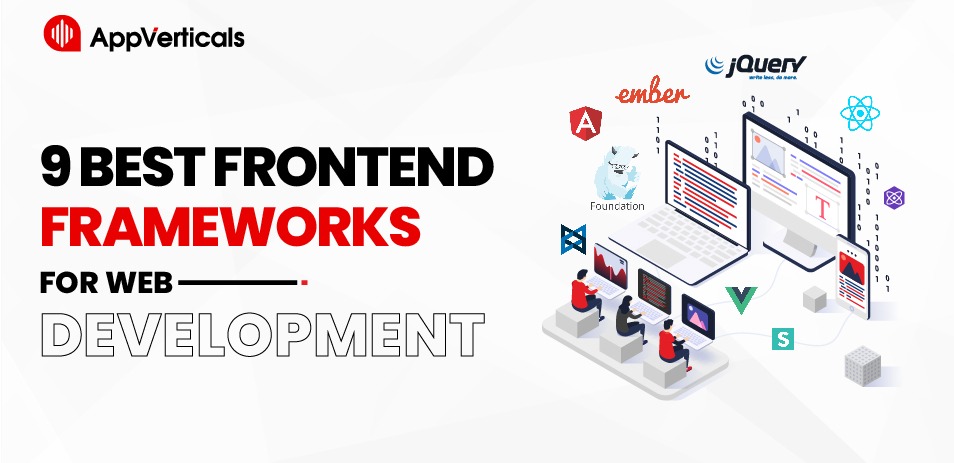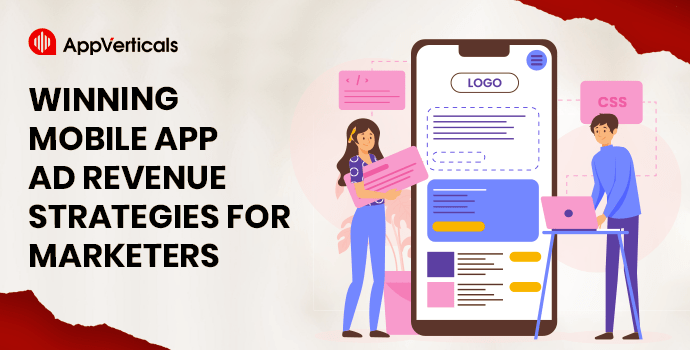Picking the right web development frontend framework is essential to build fast, responsive, and easy-to-use applications. As frontend technologies are changing quickly, choosing the right one can help speed up development, lower maintenance costs, and improve the experience for users.
Whether you’re creating a large enterprise app or a small business website, the best frontend framework can really make a difference in how your project turns out.
But there’s a small hurdle in building the actual website – Coding. That’s where frontend frameworks and the best frontend development company comes in as a web development cheat code.
Here, we’ll take a closer look at the 9 popular front end web development frameworks and how they can fit into your next project.
Let’s get started!
What Are Frontend Frameworks?
Frontend frameworks are tools that help developers build websites and web apps faster and easier. These frameworks give a set structure for designing how a website looks and works. This makes it easier to create websites that are fast, easy to use, and look good on all devices. With the fast changes in front end technologies, frameworks help developers save time and make sure their websites work well.
Factors to Consider When Choosing the Best Frontend Framework
When choosing a frontend framework for your project, there are a few important factors to think about:
1. Learning Curve:
Some frameworks are easier to learn than others. If you’re a beginner, you might want to pick a framework that’s simpler to start with. More advanced frameworks may require a better understanding of JavaScript.
2. Community Support:
A framework with a big, active community is a good choice. These communities offer helpful resources, tutorials, and advice that can make your development process smoother.
3. Active Web Development:
It’s important to choose a framework that gets regular updates. Regular updates mean the framework will stay secure and work well with new web technologies.
4. Performance:
Consider how fast the framework loads and how responsive it is. A good web development framework should help your website or app perform well, even with lots of visitors.
5. Scalability:
Some frameworks are better for smaller projects, while others are designed to handle larger apps. Think about whether your project will grow over time and if the framework can handle that growth.
By keeping these factors in mind, you’ll be able to choose the best frontend framework for your needs, whether you’re building a simple site or a larger application.
Top 9 Web Development Frontend Frameworks

1. React: For Dynamic User Interfaces
There are around 2 billion webpages on the internet and more than 1.3 use React.
React is one of the best frontend frameworks available today. Created by Facebook, React is known for being flexible, efficient, and having a large community. It uses a component-based structure, which makes it easy to create reusable pieces of a website’s user interface (UI). One of React’s standout features is its virtual DOM, which helps update the webpage quickly without causing delays.

Pros of React
- React allows developers to create components (or building blocks) that can be reused across different parts of the website or app.
- React’s virtual DOM ensures that webpage updates are quick and efficient. It ensures that only the necessary parts of the webpage are updated, helping large and complex applications run faster.
- React has a huge community of developers, which means lots of resources, tutorials, and solutions to common problems.
Cons of React
- React uses JSX, a syntax that mixes JavaScript and HTML. This can be a bit tricky for beginners to get used to, especially when learning more advanced features.
- React is constantly being updated. While this brings new features, it also means developers need to keep up with the changes to stay current with best practices.
Ideal Use Cases for React
React is great for building dynamic, interactive applications where a smooth and responsive user experience is a priority.
- It is ideal for applications like Facebook or Instagram, where the content and layout change frequently.
- It is commonly used in online stores because it can handle complex interactions and quickly update product lists, shopping carts, and user profiles.
- If you’re building a website that feels like an app with smooth transitions and real-time updates, React is the framework you want.
With React, you get a powerful frontend framework for building modern, fast, and interactive websites.
2. Vue.js: For Seamless Integrations
Vue.js is utilized by 1.1% of the websites that use the JavaScript library.
Vue.js is a popular and flexible frontend framework that’s known for its ease of use and powerful features. Created by Evan You, a former Google engineer, Vue.js is quickly becoming a top choice in the world of frontend technologies.

Pros of Vue.js
- Vue’s simple syntax and clear documentation make it beginner-friendly. It can be easily learned and integrated into your app.
- Vue has a two-way data binding feature, which means changes to the model (data) are instantly reflected in the view (user interface). This makes it perfect for building responsive applications that update in real time.
- One of the best things about Vue.js is its flexibility. It can be integrated with other web development frameworks or libraries, making it a great choice for a wide range of projects.
Cons of Vue.js
- While React and Angular have backing from big companies like Facebook and Google, Vue.js is mostly supported by the community.
- Although Vue’s ecosystem is growing, it’s not as large as React or Angular. This means you might not find as many third-party libraries or tools compared to those other frameworks.
Ideal Use Cases for Vue.js
- Vue.js is perfect for single-page applications (SPAs).
- It works best for progressive web applications (PWAs), and smaller projects where speed and flexibility are important.
- It’s also great if you want to add interactive elements to an existing website without reworking the framework completely.
3. Angular: For Large Applications
Angular daily search traffic has increased by 4.7% (155,390 more downloads per day).
Angular, created and maintained by Google, is a frontend framework that’s perfect for building large, complex web applications. Unlike some other UI frameworks, Angular offers a complete set of tools to help developers create robust apps. It comes with built-in features like routing, forms, HTTP services, and testing, making it an all-in-one solution.

Pros of Angular
- Angular is like a one-stop shop for web development. It has everything you need for large projects, so you don’t have to rely on multiple libraries.
- In Angular, any changes to your data are automatically reflected in the view and vice versa. It makes it easier to manage user interactions and updates to your data.
- Angular’s built-in structure and TypeScript support help you keep your code organized, which is great for large-scale projects that need to grow over time.
Cons of Angular
- Because Angular is powerful and complex, it can be a bit challenging for beginners or anyone used to simpler frameworks.
- While Angular is fantastic for large projects, its extensive features might slow down smaller apps, making it less suitable for lightweight websites.
Ideal Use Cases for Angular
- Angular is a great choice for big, enterprise-level applications and projects that require high performance and scalability.
- It’s perfect for complex applications in industries like finance, healthcare, and eCommerce, where handling large amounts of data and ensuring reliability is key.
4. jQuery: For Easy DOM Manipulation
jQuery is utilized by 75.8% of all websites, accounting for a 93.9% JavaScript library market share.
jQuery is a useful tool, especially when you need to simplify DOM (Document Object Model) manipulation and handle events. jQuery was created by John Resig in 2006 and quickly became a game-changer for JavaScript developers. It made it easier to interact with the DOM across different browsers. Today, it’s still valuable for smaller projects, legacy systems, or when you need to prototype quickly.

Pros of jQuery
- The syntax in jQuery is straightforward, which makes it easy for beginners to learn and use. If you’re just starting with frontend technologies, jQuery is a good place to begin.
- It automatically handles browser differences. This makes development faster and reduces issues that might arise when trying to make a website work across different browsers.
- jQuery has a huge collection of plugins available. These plugins allow you to add features to your website with minimal effort.
Cons of jQuery
- It depends heavily on the DOM and manual updates to the user interface, which can make managing complex projects harder.
- Even though jQuery is lightweight, it can cause performance problems in big, interactive applications.
Ideal Use Cases for jQuery
- jQuery is perfect when you need to quickly add interactive elements to an existing website, especially if you need compatibility with older browsers.
- jQuery is also helpful for fast prototyping or building small applications that don’t require a lot of user interaction or complex data handling.
5. Ember.js: For Building Big Web Applications
Ember has 300+ weekly downloads on NPM.
Ember.js is a strong frontend framework that’s designed for building large and complex web applications. It’s especially useful for projects that need a lot of features, structure, and long-term support. Ember follows a convention-over-configuration approach, meaning it has strong guidelines to help developers stay organized and build apps faster. If you’re working on a project that will be around for a long time and needs a stable foundation, Ember.js is a great choice.

Pros of Ember.js
- Ember has strict rules about how to organize your code, which helps developers work quickly and consistently. This is especially useful when working in large teams or on big projects where everyone needs to follow the same rules.
- Ember keeps models and views in sync automatically. If something changes in the model, the view updates, and vice versa, without the need for manual updates.
- Ember comes with useful tools like Ember CLI, which helps developers build, test, and deploy their applications.
Cons of Ember.js
- Ember has a lot of built-in features and rules, which can be challenging for new developers. The framework can take some time to learn, especially if you’re just starting with frontend technologies.
- Ember’s extensive toolset and structure might be too much for smaller, simpler projects.
Ideal Use Cases for Ember.js
- Ember is perfect for building ambitious web applications that require stability and long-term support.
- It’s ideal for large projects, like enterprise applications, social networks, or any web application that needs a lot of built-in features, such as routing, templating, and data management.
6. Backbone.js: For Building Structured Web Applications
Backbone.js is used by about 1% of websites, making it a viable option for projects requiring a lightweight and flexible solution.
Backbone.js is a lightweight frontend framework that helps developers build well-organized web applications. It offers great flexibility, giving developers control over how their applications are structured. If you like simplicity and need a framework that’s easy to understand, Backbone.js could be the right choice.

Pros of Backbone.js
- Backbone provides just the basic tools you need, such as models, views, collections, and events. It gives you freedom to design your project structure how you see fit.
- One of the best things about Backbone is how lightweight it is. It won’t slow down your app with unnecessary code.
- You can add Backbone to your existing project without a full rebuild, and it works well with other libraries or frameworks.
Cons of Backbone.js
- Unlike other frontend frameworks like Angular or Ember, Backbone doesn’t come with many built-in tools. If you want more ready-to-use features, other frameworks might be a better fit.
- Its flexibility means there are fewer rules about how you should organize your code. While this is great for smaller projects, it can lead to messy code.
Ideal Use Cases for Backbone.js
- Backbone.js is perfect for small to medium-sized applications that don’t need a lot of built-in features.
- It’s also a great option for adding structure to legacy codebases or integrating into projects where you don’t need the full power of a larger framework.
7. Preact: Fast and Efficient UI Framework
About 9.5% of JavaScript developers have experience with Preact and intend to continue using it, while 22.6% are interested in learning and adopting it for future projects.
Preact is a lightweight frontend framework that offers similar features to React, but with a much smaller size. It’s built to provide the same core features as React, like the virtual DOM and component-based structure, while keeping things fast and efficient. If you’re looking for a best frontend framework that delivers great performance without the bulk of heavier options, Preact could be the right choice.

Pros of Preact
- At around 3KB in size, Preact is one of the smallest UI frameworks available. This makes it perfect for websites or applications that need fast load times and high performance.
- If you’re already familiar with React, you’ll be happy to know that Preact is largely compatible with it. This means you can use many React libraries and tools with little or no modification.
- Preact is super fast. It excels at rendering, meaning your web apps will perform smoothly, even on mobile devices where speed is crucial.
Cons of Preact
- While Preact works well with React libraries, its ecosystem is still smaller. Some advanced features or third-party libraries may not be available.
- Since Preact is designed to be lightweight, it doesn’t come with some of the extra features and built-in tools that React offers.
Ideal Use Cases for Preact
- Preact is a great choice if you’re building mobile-first applications, static websites, or single-page applications (SPAs) where speed is a top priority.
- It’s especially useful for developers who are already comfortable with React but want a more performance-efficient, lightweight framework for their projects.
8. Semantic UI: For Easy and Beautiful Designs
Semantic UI is used by approximately 0.09% websites within the category of UI frameworks.
Semantic UI is a UI framework that helps developers create clean, easy-to-use, and visually appealing websites. What makes Semantic UI stand out is its focus on using human-readable HTML, which means the code is easy to understand.
With a range of pre-built UI components, themes, and simple customization options, Semantic UI is a great choice for developers looking to create websites with a strong visual design.

Pros of Semantic UI
- One of the best things about Semantic UI is how easy it is to read and understand the code. Instead of using generic class names like btn or button, it uses names like ui primary button.
- It comes with a wide range of pre-built UI components, like forms, buttons, modals, and grids.
- Another great feature of Semantic UI is its ability to customize themes. Developers can change the default styles to make their websites look unique, while still keeping the ease of use that Semantic UI provides.
Cons of Semantic UI
- While Semantic UI offers a lot of built-in components, its large file size can sometimes slow down the website.
- Semantic UI works great for simple websites or user interfaces, but for more complex, highly interactive web applications, it might not have the flexibility you need.
Ideal Use Cases for Semantic UI
- Semantic UI is perfect for projects that need fast development and a clean, beautiful interface.
- It’s great for building simple websites, dashboards, or content-heavy sites where design and usability are key.
- If you need a website with a strong visual presence and easy-to-use components, Semantic UI is a good choice.
9. Foundation: For Rapid Development
Foundation is used by approximately 2.1% of all websites that use a CSS framework. This is approx. 0.5% of all websites.
Foundation is a powerful frontend framework designed to help developers quickly build websites that work well on any device, especially mobile. Created by Zurb, Foundation is known for its responsive grid system and a wide range of tools that make it easier to create modern, mobile-first websites. If you’re looking for one of the best web frameworks for frontend development, Foundation is a strong contender.

Pros of Foundation
- Foundation focuses on making websites work great on mobile devices first.
- You can easily adjust Foundation to fit your needs. Whether it’s tweaking the grid system, changing UI components, or adjusting colors, Foundation gives you plenty of options.
- Foundation includes features that help make your website accessible to everyone, including users with disabilities. It supports ARIA attributes and offers color scheme options that meet accessibility standards.
- Foundation’s grid system is easy to use and flexible. It helps you create responsive layouts that adjust smoothly across different screen sizes, from mobile phones to large desktop screens.
Cons of Foundation
- Foundation can be a bit tricky for beginners to learn, especially compared to simpler frameworks like Bootstrap or Tailwind CSS. It has a lot of features, which might take a little extra time to master.
- Since Foundation is a comprehensive framework, it can lead to large files for CSS and JavaScript. If these files aren’t optimized, they might slow down your website.
Ideal Use Cases for Foundation
- Foundation is great for developers who need a flexible and customizable UI framework.
- It’s perfect for building complex, enterprise-level websites where performance, accessibility, and a mobile-first design are essential.
- It’s also a good choice if you’re working on a website or app that needs to work well on multiple devices and requires a responsive frontend.
Comparison of Top Frontend Frameworks for Web Development
| Framework | Learning Curve | Customization | Mobile-First Approach | Community Support |
| React | Moderate | High | Yes | Large |
| Vue.js | Easy | Moderate | Yes | Growing |
| Angular | Steep | High | Yes | Large |
| jQuery | Easy | Moderate | No | Very Large |
| Ember.js | Steep | Moderate | Yes | Moderate |
| Backbone.js | Moderate | Moderate | No | Moderate |
| Preact | Moderate | Moderate | Yes | Small |
| Semantic UI | Easy | High | Yes | Large |
| Foundation | Steep | High | Yes | Moderate |
Looking for the Best Frontend Development Company? We Can Help!
AppVerticals is your one-stop shop for top-notch frontend development. We’re a team of experts who can decipher the framework jungle and recommend the best fit for your project. We build websites that are not only beautiful but also user-friendly, turning visitors into fans.
AppVerticals Stays at the Forefront of the Latest Trends and Technologies.
Partner with us to ensure your web app is not only functional but innovative and future-proof.
Get a free quote!Wrapping Up!
So, you’ve unlocked the magic of frontend frameworks! By now, it’s clear that these tools are like superpowers for web development. Using a frontend framework is like having a secret weapon in your ecommerce arsenal. It empowers you to build a beautiful, user-friendly, and feature-rich online store that keeps your customers coming back for more.
FAQs – Web Development Frontend Frameworks!
1. What are the top front end frameworks?
- React
- Vue.js
- Angular
- jQuery
- Ember.js
- Backbone.js
- Preact
- Semantic UI
- Foundation
2. Is JavaScript a front end framework?
No! JavaScript is a programming language that powers interactivity on websites. Frameworks like React use JavaScript as their building block, but they offer additional pre-written code to save development time.
3. Is HTML a front end framework?
HTML is the foundation (think bricks) of a website’s structure and content. Frameworks build upon HTML to add features and style (like windows and doors). They work together to create a complete website.
4. Name one frontend framework that web developers commonly use
React is a popular frontend framework used to build responsive websites. It helps developers create interactive user interfaces quickly and easily. With React, developers can reuse code, which makes frontend development faster. React is a great tool for building fast and easy-to-use web apps.









